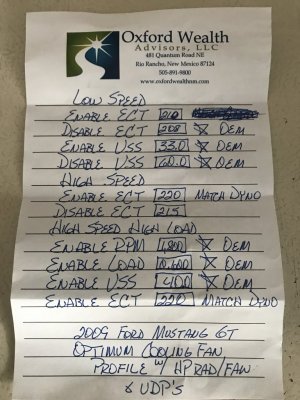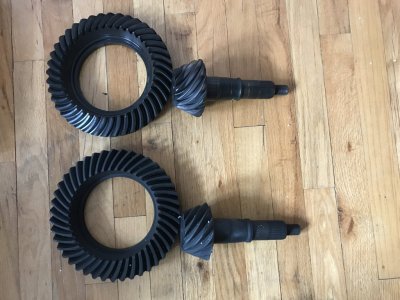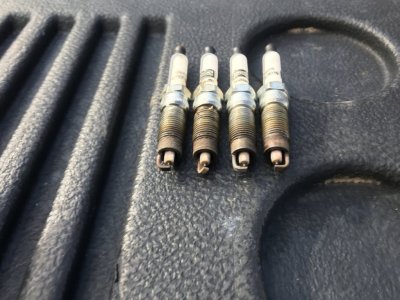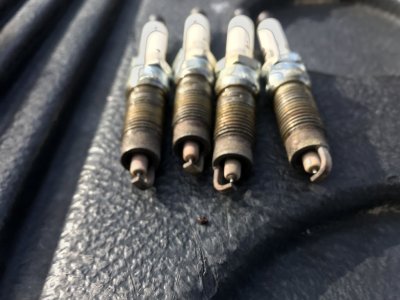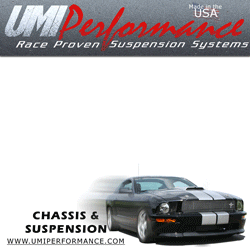3rd checkpoint:
B1 CE ratio @ .148
B2 CE ratio @ .168
CMBT @ 1,290*F
FYI..........
The reason why I clipped this particular set of recordings is I changed out my air filter (OEM Ford Performance Bullitt 85mm CAI air filter.....been on car for 18 mos+ & AM\CJ Pony Parts has discontinued providing these as a replacement part so can't get em anymore....were $35 ea) & installed a K&N E-1997 air filter (direct replacement for 08-09 Bullitt 85mm CAI.....only other recourse was WIX--don't make sense to spend the same $75-$85 for a throwaway when the K&N can be cleaned\reused) & reinstalled the same dust sock over the K&N that I had over the FP (to protect it from dust & air borne trash) so all else same except the air filter before I drove car & recorded these numbers over time.
Here are follow up readings afterwards w\ 25 total drive cycles & 257 mi on the clock:
1st checkpoint:
B1 CE ratio @ .148
B2 CE ratio @ .156
CMBT @ 1,246*F
2nd checkpoint:
B1 CE ratio @ .160
B2 CE ratio @ .168
CMBT @ 1,207*F
3rd checkpoint (after putting 47 mi of freeway driving at 70-85 MPH speeds):
B1 CE ratio @ .133
B2 CE ratio @ .129
CMBT @ 1,271*F
The big take away here is the CMBT difference since K&N filter install. Avg CMBT from 1st set of recordings is 1,327*F, the 2nd set of recordings is 1,241*F. This is an 86*F\ 7% drop in avg CMBT......just from changing out an air filter. From an understanding of how cats work, what this avg drop in CMBT is pointing to is an improvement in overall engine combustion efficiency as the increased air flow thru the K&N air filter (shown thru the LTFT avg adjustment fueling gain of +3.1% over both B1 & B2 LTFT readings prior AF changeout that I saw....denotes improved engine VE within the same operational engine RPM ranges) is causing the overall combustion to put out on avg less HC & CO in exhaust (main 2 exhaust gasses that a cat is chemically oxidizing to convert into CO2 & H2O.....are a result of incomplete combustion & chemical oxidation process creates thermal heat) so cats are not oxidizing as much HC & CO in exhaust post AF changeout thus not generating as much CMBT (even though more air\fuel is being used at same AFR) as they were before & also would suggest that NOx output is also decreased as cats use chemical reduction to break apart O2 from N2 which also creates thermal heat--this process also creates free exhaust O2 that the rear O2 sensors should pick up so keep this in mind.
Why the reading of exhaust temp prior cat vs post cat is done to determine if cat is working.......or you can just track the cat CMBT thru a scan tool.........FYI.
These results should also point to potential increased engine power output (engine using more fuel w\ more air but outputting less HC, CO & NOx = more efficient & cleaner thermal energy available to do more work).
I avg'd out the CE ratios across these last 2 sets recorded running 3.90 gears as follows:
1st avg set (FP AF):
B1 @ .130
B2 @ .169
B1\B2 avg @ .1495
2nd avg set (K&N AF):
B1 @ .147
B2 @ .151
B1\B2 avg @ .149
These results show the increase in engine combustion efficiency as engine VE increased from AF changeout but exhaust HC, CO & NOx output levels didn't follow the extra air\fuel usage--a slight overall decrease is observed from this sampling (why I mentioned to keep in mind the free O2 created from NOx reduction thru cat substrates.....avg CE ratio should have gone up from VE increase if all else stayed the same due to more free O2 getting to rear O2 sensors--not less).
Now compare to avg CE ratio numbers of what I recorded running 3.73 gears using same tune, same equip & AF as the 1st avg set after full settling of the MF #5461336 cat substrates in post #174:
B1 @ .162
B2 @ .193
B1\B2 avg @ .1775
Just another way to show the overall efficiency improvement gained from switching gear ratio from 3.73 to 3.90 (even w\ running engine RPM's increased) & engine efficiency improvement using real cat CE ratio numbers that should also show up as increased HP\TQ output from improving VE thru an air filter changeout. If you could see this FP air filter I took out, you wouldn't think it was dirty at all (these dust socks work......started using these on my tuner's recommendation that these prevent dust particles from getting thru but not impede airflow......this proved to be true during my 4-2-20 dyno session as well as the evidence of all the accumulated dust & trash in bottom of my CAI's shroud that the dust sock kept out of my air filter's pleats) but the LTFT results gained thru this K&N filter w\ the very same dust sock installed over it showed how restrictive this OEM FP Bullitt air filter was to air flow thru it.
Car runs excellent & acceleration is very crisp (this cool winter air is helping as well)! All this is confirming the 3.90 gear install was a good choice overall for what I was looking for.
I have a K&N panel filter installed in my Dodge RAM's OEM airbox but no one in my neck of the woods carried K&N replacements for a Bullitt CAI. I ordered this direct from K&N for my Mustang as no one carried these for a Bullitt CAI thru the online stores as well.
Got a set of NGK Iridium IX series plugs (got these on my tuner's recommendation) coming to drop in when I pull these used Champion 9406 Iridium plugs out to inspect them for operation to finish verifying resolution from FRPP IM & Ford F85F-9G444-BD O2 sensor replacement w\ OEM IM w\ CMDP's & used NTK 22060, 22500 O2 sensors (plug tips are still grayish white w\o electrode burn thus no detonation). Engine has performed excellent to date w\ no misfires noticed, heard thru exhaust or recorded in MM since so is a good sign that all has been resolved so we'll see soon.
Provided for informational purposes...................


